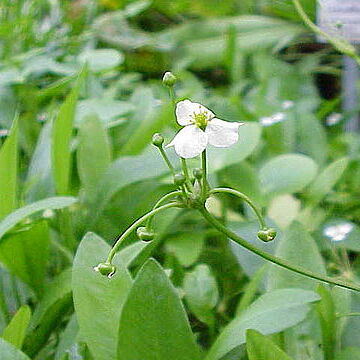Plants annual or perennial, growing emerged in fresh waters. Roots without septations. Stems rhizomatous. Leaves emerged or submersed; emerged leaves petiolate, petioles mostly triangular, rarely terete, blades linear to broadly ovate, with pellucid markings absent or present as dot or lines; submersed leaves mostly sessile phyllodes, blades mostly linear to rarely ovate, pellucid markings present as dots or lines, or absent. Inflorescences erect, emerged, racemose or paniculate scapes, rarely umbelliform, whorls 1-18; pedicels ascending to recurved. Flowers bisexual, subsessile to pedicellate; sepals herbaceous to coriaceous, without sculpturing, reflexed to spreading or rarely slightly appressed; petals white, larger than sepals; stamens 9 to many, filaments glabrous, anthers versatile or basifixed; gynoecium of many carpels, carpels 1-ovuled, styles terminal or lateral. Achenes terete, often longitudinally ribbed and glandular, rarely with a dorsal keel, separating when mature, beak lateral or terminal, erect, horizontal, or recurved.
Emerged leaves long-petioled, linear-lanceolate to ovate, base acuminate, blunt or cordate, submerged phyllodes (if present) linear. Inflorescence racemose or a panicle with whorls, sometimes an umbel which in some species is only 1-3-flowered. Bracts 2 or 3. Flowers ☿. Sepals green, dorsally striped or grooved. Petals delicate, often much exceeding the sepals. Stamens 6, 9, 12 or ∞; filaments filiform; anthers oblong. Carpels ∞, spirally arranged on a globular or oblong receptacle; style terminal. Achenes not, slightly, or strongly compressed, with lateral ribs or not, beaked. Seeds broad-elliptic, the testa following the hippocrepiformous seed but connate in the incision.
Fls perfect; receptacle elevated, convex or globose; sep 3, persistent, sometimes accrescent; pet 3, white, deciduous; stamens 6–30; filaments elongate; pistils borne in several series and aggregated into a globose head; achenes turgid, evenly ribbed or ridged; scape erect or prostrate, bearing an infl of 1–many verticils of fls, sometimes branched from the lower verticils; verticils 3-bracted and commonly with additional bracteoles. (Helianthium) 20+, widespread, mainly tropical.
Annual or perennial, usually acaulescent, marsh herbs. Leaves erect or ascend-ing, narrow or broad, cordate or attenuate at the base. Flowering scapes generally surpassing the leaves, simple or branched, bearing 1 to numerous whorls of flowers, the pedicels short or virtually lacking. Flowers all perfect; sepals 3, green; petals 3, white or pink; stamens few or numerous; carpels numerous; fruit an achene.

